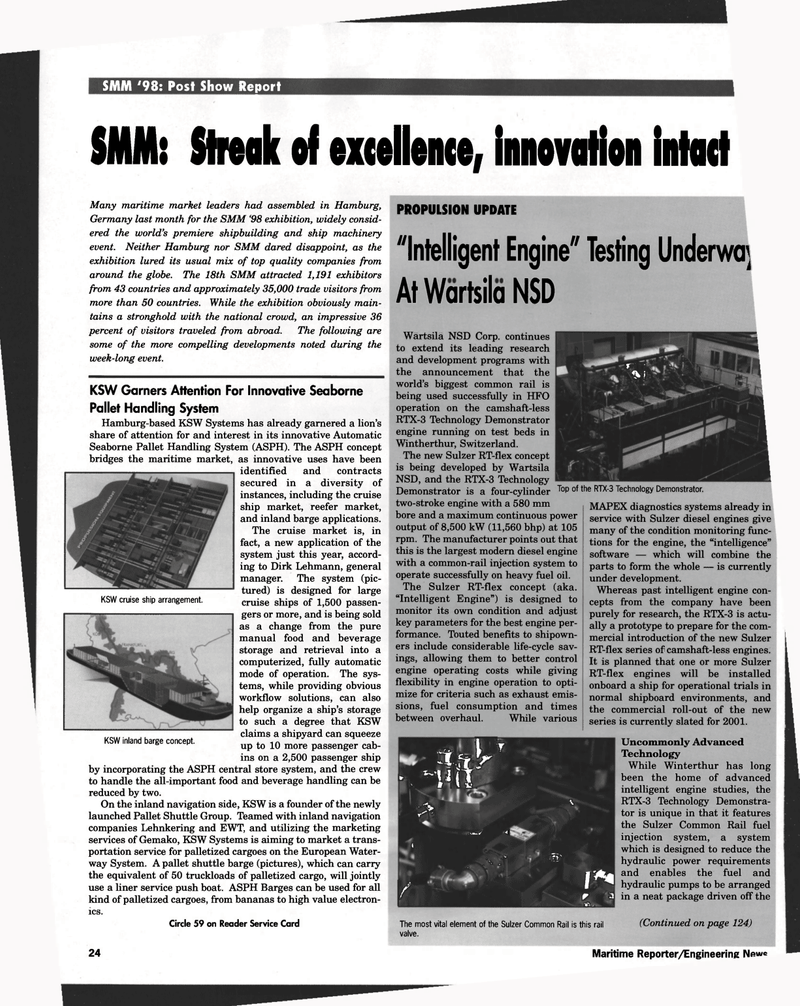
Page 24: of Maritime Reporter Magazine (November 1998)
Read this page in Pdf, Flash or Html5 edition of November 1998 Maritime Reporter Magazine
SMM '98: Post Show Report
SMM: Streak of excellence, innovation intact
Many maritime market leaders had assembled in Hamburg,
Germany last month for the SMM '98 exhibition, widely consid- ered the world's premiere shipbuilding and ship machinery event. Neither Hamburg nor SMM dared disappoint, as the exhibition lured its usual mix of top quality companies from around the globe. The 18th SMM attracted 1,191 exhibitors from 43 countries and approximately 35,000 trade visitors from more than 50 countries. While the exhibition obviously main- tains a stronghold with the national crowd, an impressive 36 percent of visitors traveled from abroad. The following are some of the more compelling developments noted during the week-long event.
KSW Garners Attention For Innovative Seaborne
PROPULSION UPDATE 'Intelligent Engine" Testing Underway
At Wartsila NSD
Wartsila NSD Corp. continues to extend its leading research and development programs with the announcement that the world's biggest common rail is being used successfully in HFO operation on the camshaft-less
RTX-3 Technology Demonstrator engine running on test beds in
Wintherthur, Switzerland.
The new Sulzer RT-flex concept is being developed by Wartsila
NSD, and the RTX-3 Technology
Demonstrator is a four-cylinder two-stroke engine with a 580 mm bore and a maximum continuous power output of 8,500 kW (11,560 bhp) at 105 rpm. The manufacturer points out that this is the largest modern diesel engine with a common-rail injection system to operate successfully on heavy fuel oil.
The Sulzer RT-flex concept (aka. "Intelligent Engine") is designed to monitor its own condition and adjust key parameters for the best engine per- formance. Touted benefits to shipown- ers include considerable life-cycle sav- ings, allowing them to better control engine operating costs while giving flexibility in engine operation to opti- mize for criteria such as exhaust emis- sions, fuel consumption and times between overhaul. While various
V
I T X.ft r * n* I > w *
V 1
JH JT K f 1*4 r 3 '•Ml
ICS.
Circle 59 on Reader Service Card The most vital element of the Sulzer Common Rail is this rail valve.
Top of the RTX-3 Technology Demonstrator.
MAPEX diagnostics systems already in service with Sulzer diesel engines give many of the condition monitoring func- tions for the engine, the "intelligence" software — which will combine the parts to form the whole — is currently under development.
Whereas past intelligent engine con- cepts from the company have been purely for research, the RTX-3 is actu- ally a prototype to prepare for the com- mercial introduction of the new Sulzer
RT-flex series of camshaft-less engines.
It is planned that one or more Sulzer
RT-flex engines will be installed onboard a ship for operational trials in normal shipboard environments, and the commercial roll-out of the new series is currently slated for 2001.
Uncommonly Advanced
Technology
While Winterthur has long been the home of advanced intelligent engine studies, the
RTX-3 Technology Demonstra- tor is unique in that it features the Sulzer Common Rail fuel injection system, a system which is designed to reduce the hydraulic power requirements and enables the fuel and hydraulic pumps to be arranged in a neat package driven off the (Continued on page 124)
Pallet Handling System
Hamburg-based KSW Systems has already garnered a lion's share of attention for and interest in its innovative Automatic
Seaborne Pallet Handling System (ASPH). The ASPH concept bridges the maritime market, as innovative uses have been identified and contracts secured in a diversity of instances, including the cruise ship market, reefer market, and inland barge applications.
The cruise market is, in fact, a new application of the system just this year, accord- ing to Dirk Lehmann, general manager. The system (pic- tured) is designed for large cruise ships of 1,500 passen- gers or more, and is being sold as a change from the pure manual food and beverage storage and retrieval into a computerized, fully automatic mode of operation. The sys- tems, while providing obvious workflow solutions, can also help organize a ship's storage to such a degree that KSW claims a shipyard can squeeze up to 10 more passenger cab- ins on a 2,500 passenger ship by incorporating the ASPH central store system, and the crew to handle the all-important food and beverage handling can be reduced by two.
On the inland navigation side, KSW is a founder of the newly launched Pallet Shuttle Group. Teamed with inland navigation companies Lehnkering and EWT, and utilizing the marketing services of Gemako, KSW Systems is aiming to market a trans- portation service for palletized cargoes on the European Water- way System. A pallet shuttle barge (pictures), which can carry the equivalent of 50 truckloads of palletized cargo, will jointly use a liner service push boat. ASPH Barges can be used for all kind of palletized cargoes, from bananas to high value electron-
KSW cruise ship arrangement.
KSW inland barge concept. 24 Maritime Reporter/Engineering Newc

 23
23

 25
25
